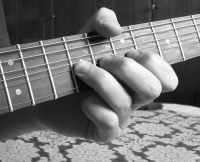
An electric guitar is a guitar that requires external electric sound amplification in order to be heard at typical performance volumes, unlike a standard acoustic guitar. It uses one or more pickups to convert the vibration of its strings into electrical signals, which ultimately are reproduced as sound by loudspeakers. The sound is sometimes shaped or electronically altered to achieve different timbres or tonal qualities via amplifier settings or knobs on the guitar. Often, this is done through the use of effects such as reverb, distortion and "overdrive"; the latter is considered to be a key element of electric blues guitar music and jazz, rock and heavy metal guitar playing. Designs also exist combining attributes of electric and acoustic guitars: the semi-acoustic and acoustic-electric guitars.

The guitar is a stringed musical instrument that is usually fretted and typically has six or twelve strings. It is usually held flat against the player's body and played by strumming or plucking the strings with the dominant hand, while simultaneously pressing selected strings against frets with the fingers of the opposite hand. A guitar pick may also be used to strike the strings. The sound of the guitar is projected either acoustically, by means of a resonant hollow chamber on the guitar, or amplified by an electronic pickup and an amplifier.
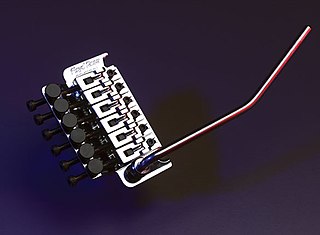
The Floyd Rose Locking Tremolo, or simply Floyd Rose, is a type of locking vibrato arm for a guitar. Floyd D. Rose invented the locking vibrato in 1976, the first of its kind, and it is now manufactured by a company of the same name. The Floyd Rose gained popularity in the 1980s through guitarists like Eddie Van Halen, Neal Schon, Brad Gillis, Joe Satriani, Steve Vai, and Alex Lifeson, who used its ability to stay in tune even with extreme changes in pitch. Its tuning stability comes through the double-locking design that has been widely regarded as revolutionary; the design has been listed on Guitar World's "10 Most Earth Shaking Guitar Innovations" and Guitar Player's "101 Greatest Moments in Guitar History 1979–1983."
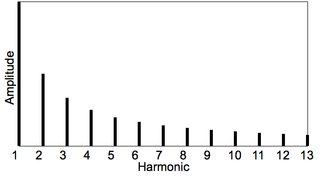
In music, inharmonicity is the degree to which the frequencies of overtones depart from whole multiples of the fundamental frequency.

A twelve-string guitar is a steel-string guitar with 12 strings in six courses, which produces a thicker, more ringing tone than a standard six-string guitar. Typically, the strings of the lower four courses are tuned in octaves, with those of the upper two courses tuned in unison. The gap between the strings within each dual-string course is narrow, and the strings of each course are fretted and plucked as a single unit. The neck is wider, to accommodate the extra strings, and is similar to the width of a classical guitar neck. The sound, particularly on acoustic instruments, is fuller and more harmonically resonant than six-string instruments. The 12-string guitar can be played like a 6-string guitar as players still use the same notes, chords and guitar techniques like a standard 6-string guitar, but advanced techniques can be challenging as players need to play or pluck two strings simultaneously.

A machine head is a geared apparatus for tuning stringed musical instruments by adjusting string tension. Machine heads are used on mandolins, guitars, double basses and others, and are usually located on the instrument's headstock. Other names for guitar tuners include pegs, gears, machines, cranks, knobs, tensioners and tighteners.
A vibrato system on a guitar is a mechanical device used to temporarily change the pitch of the strings. It adds vibrato to the sound by changing the tension of the strings, typically at the bridge or tailpiece of an electric guitar using a controlling lever, which is alternately referred to as a whammy bar, vibrato bar, or tremolo arm. The lever enables the player to quickly and temporarily vary the tension and sometimes length of the strings, changing the pitch to create a vibrato, portamento, or pitch bend effect. Instruments without a vibrato have other bridge and tailpiece systems.
Steinberger is a series of distinctive electric guitars and bass guitars, designed and originally manufactured by Ned Steinberger. The name "Steinberger" can be used to refer to either the instruments themselves or the company that originally produced them. Although the name has been applied to a variety of instruments, it is primarily associated with a minimalist "headless" design of electric basses and guitars.
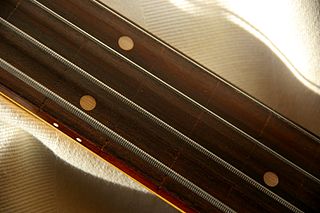
In music, strings are long flexible structures on string instruments that produce sound through vibration. Strings are held under tension so that they can vibrate freely. The pitch (frequency) at which a string will vibrate is primarily related to its vibrating length, its tension, and its mass per unit of length. A vibrating string produces very little sound by itself. Therefore, most string instruments have a soundboard to amplify the sound.

A tailpiece is a component on many stringed musical instruments that anchors one end of the strings, usually opposite the end with the tuning mechanism.
A nut, on a stringed musical instrument, is a small piece of hard material that supports the strings at the end closest to the headstock or scroll. The nut marks one end of the vibrating length of each open string, sets the spacing of the strings across the neck, and usually holds the strings at the proper height from the fingerboard. Along with the bridge, the nut defines the scale lengths of the open strings.
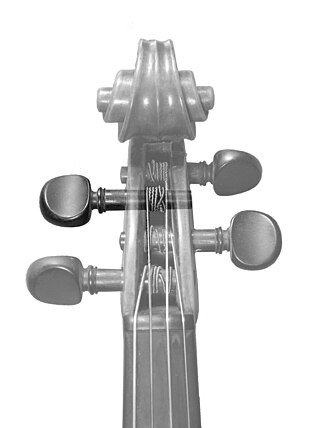
A variety of methods are used to tune different stringed instruments. Most change the pitch produced when the string is played by adjusting the tension of the strings.

A headstock or peghead is part of a guitar or similar stringed instruments such as a lute, mandolin, banjo, ukulele and others of the lute lineage. The main function of a headstock is to house the tuning pegs or other mechanism that holds the strings at the "head" of the instrument; it corresponds to a pegbox in the violin family. At the "tail" of the instrument the strings are usually held by a tailpiece or bridge. Machine heads on the headstock are commonly used to tune the instrument by adjusting the tension of strings and, consequently, the pitch of sound they produce.
The truss rod is a component of a guitar or other stringed instrument that stabilizes the lengthwise forward curvature of the neck. Usually, it is a steel bar or rod that runs through the inside of the neck, beneath the fingerboard. Some are non-adjustable, but most modern truss rods have a nut at one or both ends that adjusts its tension. The first truss rod patent was applied for by Thaddeus McHugh, an employee of the Gibson company in 1921, though the idea of a "truss rod" appears in patents as early as 1908.

A zero fret is a fret placed at the headstock end of the neck of a banjo, guitar, mandolin, or bass guitar. It serves one of the functions of a nut: holding the strings the correct distance above the other frets on the instrument's fretboard. A separate string-guide is still required to establish the correct string spacing when a zero fret is used.

The Gibson Robot Guitar is a limited-edition self-tuning Gibson guitar, typically a Les Paul. The first run of limited edition Robot Guitars was exclusively made up of Les Paul bodies. Five different Gibson models were available ) with Robot Guitar features: The Robot Les Paul Studio, Robot SG, Robot Flying V, Robot X-plorer, and a Robot Les Paul Junior. Developed by Chris Adams, its most notable feature is that it uses an onboard computer to automatically tune itself. This is not the first guitar to be able to tune itself, but it is regarded as the most modern, unique, and non-invasive self-tuning model available, because it does not employ cams or cantilevers throughout the body of the guitar.

The Stetsbar Tremolo system is a vibrato bridge system for the electric guitar. Eric Stets developed the device in the late ‘80s, and patented it in 1995. He originally designed the device to provide a stable vibrato system that could retrofit to “stop-tail” guitars such as the Gibson Les Paul with no permanent modifications to the instrument.
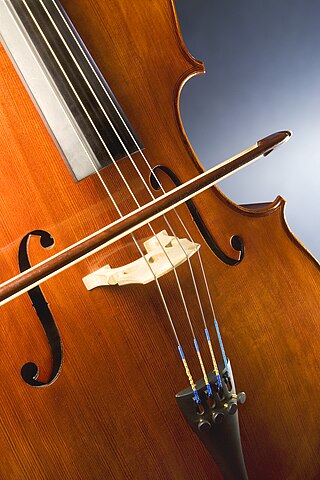
A bridge is a device that supports the strings on a stringed musical instrument and transmits the vibration of those strings to another structural component of the instrument—typically a soundboard, such as the top of a guitar or violin—which transfers the sound to the surrounding air. Depending on the instrument, the bridge may be made of carved wood, metal or other materials. The bridge supports the strings and holds them over the body of the instrument under tension.
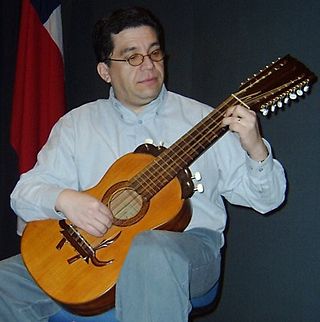
The Guitarrón Chileno is a guitar-shaped plucked string instrument from Chile, with 25, 24 (rarely), or even 26 strings. Its primary contemporary use is as the instrumental accompaniment for the traditional Chilean genre of singing poetry known as Canto a lo Poeta, though a few virtuosi have also begun to develop the instrument's solo possibilities.

Roadie tuners are automatic stringed instrument tuners created and developed by the music-tech startup, Band Industries, Inc. Roadie 3, the last iteration in the Roadie tuner family is compatible with stringed instruments that have a guitar machine head including electric, acoustic, classical and steel guitars, 6-7-12 string guitars, ukuleles, mandolins and banjos. Roadie Bass is designed to tune bass guitars as well as the instruments Roadie 3 can tune.
